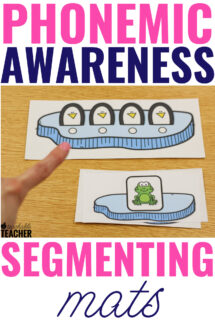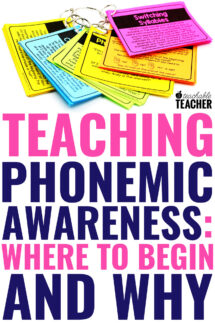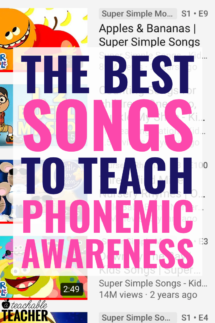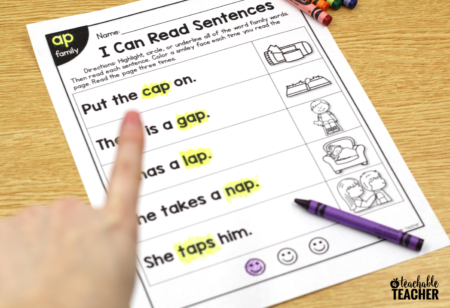Songs are an excellent way to build phonemic awareness skills because they focus on the task of listening. These songs are teacher-approved and perfect for building and practicing phonemic awareness skills.
Why Phonological and Phonemic Awareness are Hard
Have you ever wondered why phonological and phonemic awareness can be such a hard concept for students to grasp. 😣
First of all, gaining phonological and phonemic awareness is an abstract concept. That alone makes it more difficult to understand.
Second, this is the first time where hearing the word (and the sounds inside of the word) matters more than what the word means.
Since they were born, they’ve been learning how to communicate. When you’re learning a language, not only do you hear the whole word, but the focus is on what the whole word means.
For example: What’s the point of being able to hear and say the word dog, if an image of a dog doesn’t pop into the child’s mind? You can say dog or hear dog, but it’s meaningless in communicating if you don’t know what dog means.
They’ve spent their whole lives focusing on word meaning. Now we are asking them to focus on the sounds of a word and not the meaning.
Has this ever happened to you? You ask the students, “What word rhymes with dog?” They reply with: cat, bone, paw. 🤦🏽♀️
And you think: Those do not even come close to rhyming…why are they saying that? It’s because they are naturally focusing on the meaning of the word instead of the sounds inside of the word.
Phonemic Awareness Songs
Building Listening Skills for Phonemic Awareness
Whether you’re working on rhyming or manipulating sounds or syllables, each skill comes back to one thing: being able to hear what’s happening to the sounds in words.
Teaching these skills can feel like a daunting task because it is all about listening ?. That’s why I love to use songs to teach phonemic awareness. The rhythm and music lend themselves to learning and practicing theses skills.
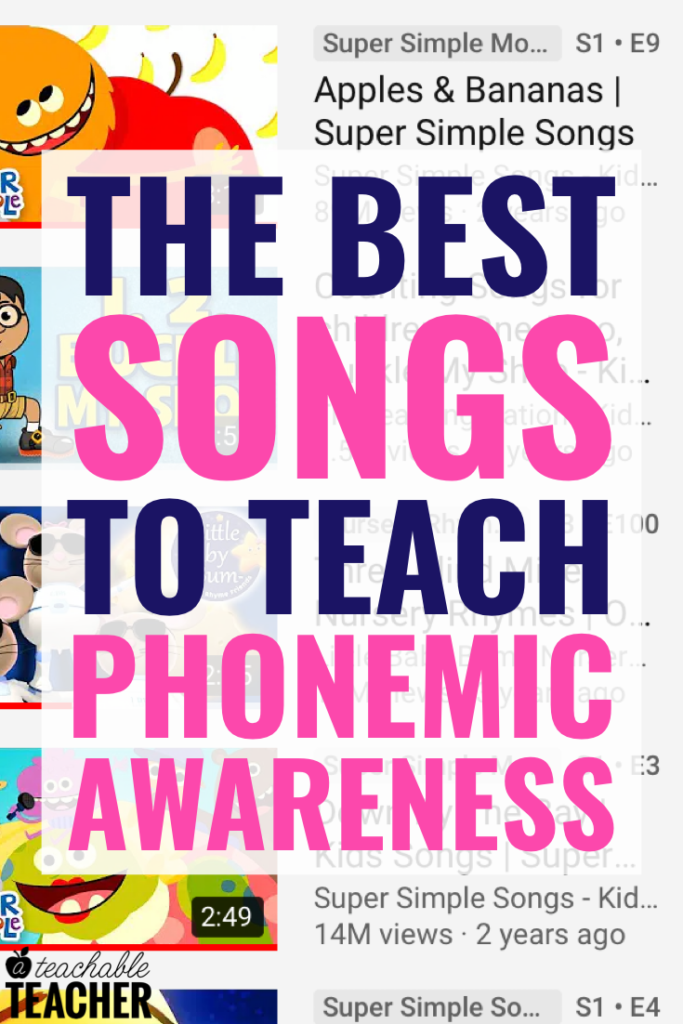
Do you know the difference between phonological awareness and phonemic awareness? I used these terms interchangeably for years, but they’re actually quite different. Read this post to learn the difference phonological awareness VS phonemic awareness.
Learning Videos for the Classroom
While I personally believe these videos are appropriate for first and second grade classrooms, remember that there can often be inappropriate ads before and after YouTube videos. Also, I always recommend previewing the full video before showing it to your class.
If you plan to show YouTube videos in your classroom, I highly recommend that you read this blog post by Catherine, the Brown Bag Teacher. She shares three ways to eliminate YouTube video ads so that you can safely play these learning videos in your classroom.
Phonological Awareness Songs
Since phonological awareness and phonemic awareness activities build on each other, I like to practice a few phonological awareness skills first.
Even if some of your kiddos have mastered hearing and manipulating words, syllables, and onset and rime, it never hurts to use these phonological awareness songs as a warm-up. It’s just more listening practice, and you can’t go wrong with that!
Syllable Songs
Miss Mary Mack
The cadence of this song is what really lends it so perfectly to phonological awareness practice. We practice rhyming as they finish the sentences.
When they are more comfortable with the verses we practice counting the syllables in the different words.
Going On a Bear Hunt
First of all, this song is just fun. That’s a good enough reason to use it as a break in the day. ? It also just happens to be perfect for practicing lots of syllables, too!
The rhythm of the song is perfect for practicing syllables. We clap out several of the words and match them to each other. For example “We can’t go over it,” is 6 syllables. “We can’t go under it” is 6 syllables, too!
Additionally, all of the actions are a single syllable. We discuss why they might have used words with the same amount of syllables in each part of the song.
Rhyming Songs
1, 2, Buckle My Shoe
This familiar nursery rhyme is perfect to practice rhyming because many kids are already comfortable with it.
To extend our phonological awareness practice, I like to ask “What else could rhyme with the number two? We practice putting other words into the rhyme and make silly sentences.
Bonus: This can also be a practice of word discrimination and phoneme manipulation!
Down by the Bay
Down by the Bay is a classic for a reason! Kids love the silly, rhyming word sentences that tell them what they may see down by the bay.
There are rhymes all over this song! We don’t just listen for the rhymes in the verses. We also try to find rhyming words in the chorus (like “say” and “bay”).
Finally, once we are comfortable with the song, we come up with our own silly things we might see by the bay. This means we have moved on from identifying rhymes to creating them! #teacherwin
Perhaps we will see a man getting a tan or a cat chasing a rat. Not only are we rhyming but we are changing the beginning phoneme to make the new rhyme. So much important practice is happening!
Phonemic Awareness Songs
Sound Discrimination Practice
Apples and Bananas
This is the perfect silly song to practice multiple phonemic awareness skills.
Kids will hear a difference in the sounds they are singing. Most often when practicing sound discrimination we focus on the beginning or end of a word. This gives kids a chance to practice listening for the vowel sound!
We are also practicing phoneme manipulation in this song. The vowel sound changes with each verse of the song but the other sounds stay the same. We change a single sound in a word and can hear how the whole word changes.
Willaby Wallaby Woo
We love to use this song as at the beginning of the school year to practice names as well as phonemic awareness skills. We will sing it without the video during our morning circle time or when we need a time filler before lunch or specials.
This song practices several phonemic awareness skills. Most notably, it works on rhyming. Kids can guess the name of the student you are singing about.
When you say “Willaby Wallaby Wauren…” They think they are so clever as they sing the answer back to you: Lauren!
Because you’re changing the beginning sound of each name, you are also practicing phoneme manipulation! See if your kids can figure out what their name might be in the song and let them sing a verse!
When they get comfortable with the “w” I change it to another letter and now the song is “Tillaby Tallaby too” or whatever fits with what we are currently working on.
Phonological and Phonemic Awareness Videos
The fun doesn’t have to stop there! Check out these engaging videos for practicing phonemic awareness!
Do you have any favorite songs to practice phonological and phonemic awareness with your new readers? I would love to hear them. Please share below! 👇

